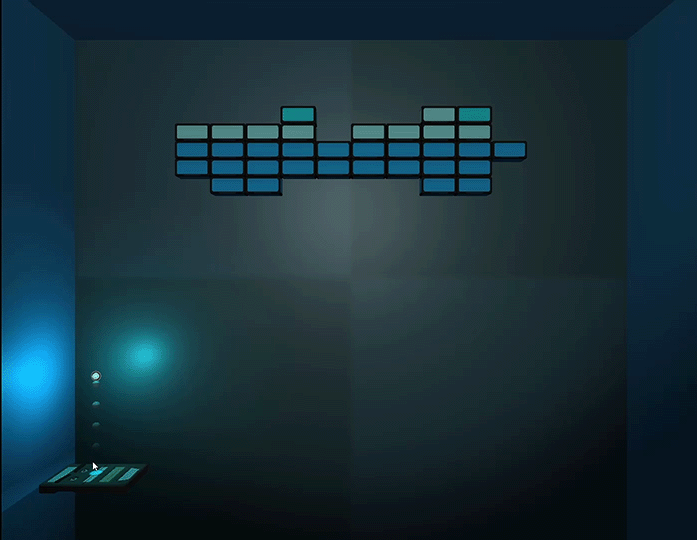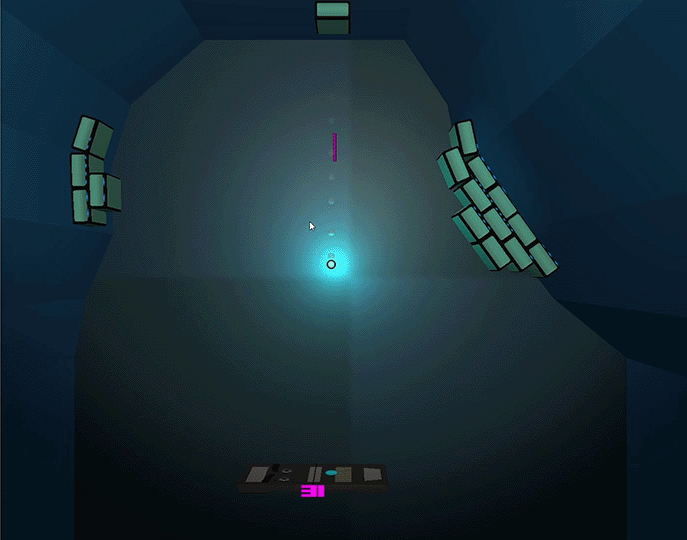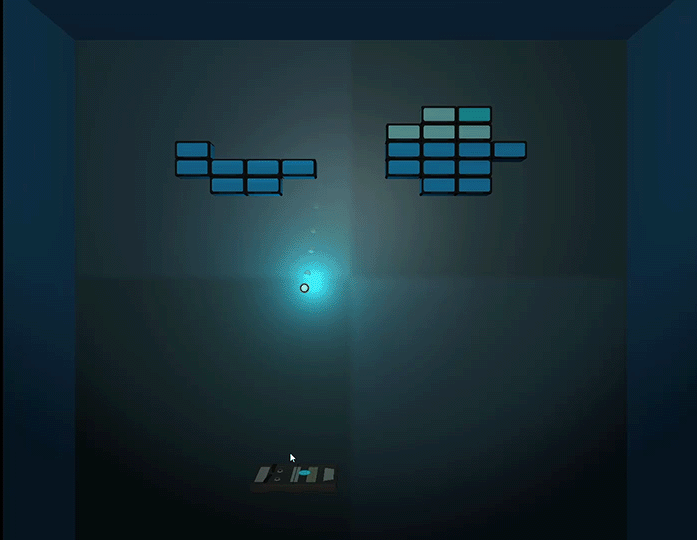
SEVA ZAKHARENKO
BREK - RE-IMAGINING A CLASSIC
INSPIRATION
DX Ball was my primary inspiration for this project because I felt like it was a great brick breaker game at the time, it just needed some modern day love. I began by deconstructing DX Ball down to its core mechanics, and seeing where each could be updated. The mechanics that I decided were necessary to design Brek were:
-
Ball and paddle movement / player control
-
“Level Design”
-
Power-ups and Curses
-
Re-playability and Scoring
I’ll go through each topic and what I felt was lacking in the original and my approach to “improving” it. Of course, my idea of an improvement is entirely subjective, though I hope you find my insight interesting nonetheless.

DX-Ball Gameplay
BALL AND PADDLE MOVEMENT:
In DX-Ball, the paddle moved along the x-axis in perfect sync with the mouse. Though this was a sensible design choice, the movement felt a little too stiff. Furthermore, one of the mechanics I wanted to implement later on was modulated paddle speed, something that wouldn’t work if the paddle was 'attached' to the mouse. I decided to make the paddle move faster the further it is from the mouse. This made the paddle movement more natural and ‘wavy’ while keeping most of the speed from the original game. I also added a streak to the ball, as well as an indicator on the paddle to make tracking the ball easier at higher speeds.


Ball ghost trail and ball position indicator
This small update did make the gameplay feel smoother and more satisfying, however, I quickly realized that the right hand was doing all the work. Despite giving the player better control of the ball, it wasn’t enough, especially at the end of a level. When a level came down to the final few bricks, the game became more frustrating than fun.
Getting the keyboard involved in the game opened up several opportunities for new techniques. The first technique added was a small ‘punt’ to the ball. By pressing the ‘A’ and ‘D’ keys repeatedly, the player can steer the ball ever so slightly in the direction they want. This did make the game much easier at low speeds, but as the game got faster, the player would have to mash the keys very quickly to maintain control of the ball. The second ability I added was the ‘hard drop.’ Some environments had bricks that were angled in ways that could send the ball bouncing almost horizontally for long periods of time. To combat this, the hard-drop ability would send the ball straight down to the paddle as long as the ball had line of sight to the paddle, and the ball was already moving downward.
In DX-Ball, if you were down to the last brick, it would be automatically destroyed by lightning after about a minute. But if there were two or more bricks, you were on your own. Because of this, I wanted to give the player even more control, specifically, by putting the left hand to work

We all felt this pain, so let's do our best to avoid it

Example of "hard drop" being used in action

Example of "punting" being used in action
Level Design:
In DX-Ball, there isn’t too much in the way of level design. Generally speaking, a level consists of a simple, fun pattern of colorful bricks. In order to breathe new life into the level design, I went with two major changes: level randomization and a “Story” mode. The first change was simple. Some bricks in certain levels would have a randomized health value. Certain bonus bricks or explosive bricks would change positions from play to play. The second change was more ambitious.
One of the main focal points of the Story mode was teaching the player the rules of the game. The player is introduced to each power-up and game mechanic slowly so as not to be overwhelmed. Each introductory level was designed in a way that gives the player the most optimal environment to utilize a specific power-up.

A mountain castle level, where the castle attacks the player with a projectile
For Example, the ‘Detonate’ power-up is introduced in a level where explosive bricks are laid out just right to destroy a majority of the level in a satisfying way. The ‘Laser’ power-up is introduced in a string of levels where bricks become more challenging to hit. The Laser gives the player an additional means of destroying bricks that are otherwise difficult to break with the ball. These power-ups were the crux of the story mode progression and, thus, received a lot of attention.

A Boss battle with a giant bat that tests the player's usage of lasers.
POWER-UP AND CURSE DESIGN
Brek has two types of primary collectibles: Power-Ups (Boons) and Curses. Boons give the player an advantage in the game and are introduced in the first several stages. Curses, on the other hand, will cause the player grief and are not introduced until much later in the game. Generally speaking, DX Ball's boons felt very unbalanced, so a very lucky player would have a tremendous advantage over someone less fortunate. I wanted to equalize the power of each boon so that they all felt powerful, and reduce the likelihood that a player would find something completely useless. There is a lot to unpack in this category, so for a full analysis of boon and curse design, follow the link below:
Replayability and Scoring:
Brek has a short campaign consisting of 24 levels. Once the game is complete, the player will have access to two new game modes: Score Run and Brick-Tris. Both of these games were intended to squeeze more fun out of already existing gameplay without too much work.
Score Run in Detail:
Score Run is an original concept not found in DX Ball. Score Run allows the player to play the campaign with the intention of getting the highest score possible. The player has additional options on each level to intentionally make it more difficult with the goal of increasing their score. For example, the player has the option to start with a smaller than normal paddle, a faster ball, or increased Curse drop chance. The more difficult the level is for the player, the higher the player can score. There is a risk to raising the difficulty. If the player fails to complete a level, their total score is reduced by 25%. This gives the chance for brave players to truly shine.
Scoring is also calculated differently in Brek than in DX Ball. In DX Ball, points were awarded for collecting power-ups (and curses) and for destroying bricks. Points awarded for destroying bricks remained the same regardless of difficulty or what level the player got to. In Brek, score is calculated with a bit more complexity.
-
Each brick has a base score. This amount is based on the health of the brick, as well as how much of the level is cleared. The more the level is cleared, the more each remaining brick is worth.
-
Secondly, there is a difficulty multiplier. This multiplier changes depending on how “difficult” the player’s current situation is. This is a combination of ball speed, pad size, and other level-specific modifications.
-
Thirdly, the player’s current health affects score. The lower the player’s health is, the less each brick is worth.
-
Finally, there is a combo multiplier. If the player can manage to hit (not necessarily destroy) two bricks within a few seconds of each other, a combo timer starts. Each time a brick is destroyed, the combo increases by 0.1x (the multiplier starts at 1.0x and maxes out at 4.0x). If the player fails to hit a brick within the combo time or loses their ball, the combo resets to 1.0x.

Score Run screen that allows players to increase difficulty (in this case ball speed and paddle size) to raise their potential score.
Ultimately, the highest score is earned by the player who maxes out the current level’s difficulty, never loses any health, and can clear the entire level in a single combo.
BrickTris in Detail:
Brick-Tris, on the other hand, is an arcade style mini-game, inspired by Tetris. In Brick-Tris, the player must clear downward moving arrangements of bricks in increasing levels of difficulty for a high score. The game starts at level 0, and increases by 1 each time the player clears the board. As the levels increase, several factors make the game more challenging for the player:
-
Higher levels spawn more bricks
-
Higher levels can grant more health to each brick
-
Bricks at higher levels have an increased chance to be armored
-
Curses drop more frequently at higher levels
-
Naturally, the ball will move faster at higher levels, though this is actually tied to how many surfaces the ball has hit.
-
Bricks have a chance to be ‘aggressive’ at higher levels, attacking the player with lasers. (WIP)

Bricktris gameplay
Each time a brick hits the bottom of the board, the player loses 5 health points. Losing a ball randomly deals 30-40 damage to the player. As usual, when the player reaches zero health, it is game over. The objective is to get the highest score possible before the levels become too overwhelming. All upgrades and curses found in the campaign are found within Brick-Tris as well.
Bricktris also features dynamic music which changes based on the player's progress. There are also sound effects that play to the tempo of the music. For a full analysis and video demonstration of Bricktris, check out the link below:
Playable demo of the Brek campaign mode and Brick-Tris available upon request!